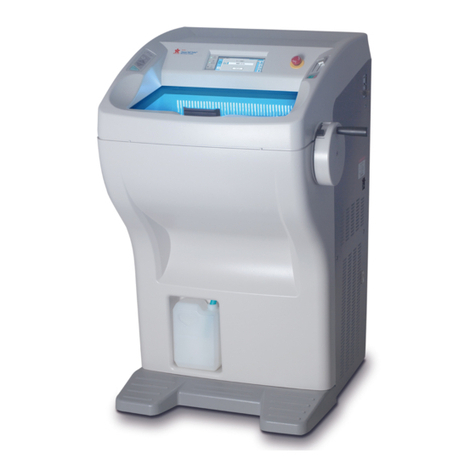
Revised 08/08/2013 1.1
Section 1
INTRODUCTION
Intended Use
The Tissue-Tek®Film®Automated Coverslipper is
designed for the purpose of coverslipping human and
animal tissue specimens on slides.
The instrument, as part of the histopathology process,
is intended to facilitate the in vitro examination of human
and animal tissue for morphology changes by a
pathologist.
General Description
The Tissue-Tek®Film®Automated Coverslippers
designed to coverslip biological specimens that are
mounted on standard 25 x 75 mm (1 x 3 inch) microscope
slides (Figure 1-A). The use of a special, resin-coated, film
and xylene eliminates the need for cover glass and
mounting media. (Sakura can only recommend the use of
Tissue-Tek®Coverslipping Film because of its proven
performance). The film length is user-defined in four
selectable options: 45 mm, 50 mm, 55 mm, and 60 mm.
Coverslipping is performed at approximately 3 seconds
per slide with continuous processing of up to 3 pre-loaded
baskets. By linking the Film Coverslipper to the Tissue-
Tek®Prisma®Slide Stainer, the series of slide preparation
from slide staining to coverslipping is automatically
performed. A microcomputer controls the mechanical
movements, as well as the positioning and length of the
coverslipping film. An LCD offers a visual display of
selectable options and instrument status. All operating
functions are controlled through a control panel.
Adjustments to the software, such as xylene dispensing
volume and film length can be easily modified using the
function keys on the display panel.
Specimen slides ready for coverslipping are placed
into compatible baskets and loaded into the basket
loading station. The loading station should contain xylene
in order to protect the specimens from drying out prior to
coverslipping. The loading station can accommodate 3
baskets (60 slides) at one time. When the loading door is
closed, sensors detect the number of baskets placed in
the loading station. A robotic arm picks up one basket at a
time and rises to the coverslipping area. Each slide is
ejected from the basket where a pre-determined amount
of xylene is dispensed onto the slide. The coverslipping
film is applied to the slide and the slide is then returned to
its original position in the slide basket. When all of the
slides in the basket have been coverslipped, the basket is
transferred to the 12-position unloading unit. Baskets can
be removed immediately or stored until 12 baskets have
been placed in the unloading area. Use of an optional
automatic transfer link station enables the coverslipper to
receive slides directly from the Tissue-Tek®Prisma®
Automated Slide Stainer.
Figure 1-A
The Tissue-Tek Film Automated Coverslipper with
Code Reader, product code 4743, includes a bar code
reader installed inside the unit. The 4740 version of the
Tissue-Tek Film Automated Coverslipper arrives pre-wired
for a bar code reader which may be added later with the
purchase of product code 6508. This addition requires
installation by a Sakura Service professional. Please refer
to Appendix A for further instructions pertaining to
bar code reader functions.




























